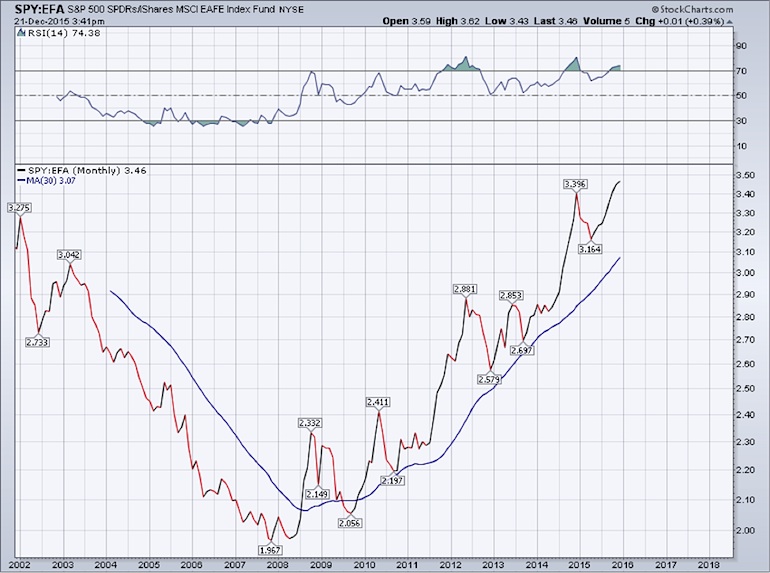The following monthly chart illustrates the ratio of two exchange-traded funds, ticker symbols SPY and EFA, a proxy for domestic and international stocks. I’m using a monthly chart covering the last 14 years and I’ve added the 30-month simple moving average (30 SMA) for trend identification purposes, or in laymen’s terms to help us identify the relative strength across the two securities.
When the ratio is greater than its 30 SMA and ascending, the primary trend favors domestic equities, and therefore diversifying internationally may not prove equitable. Conversely, when the ratio is less than its 30 SMA and descending, the primary trend favors international equities.
This may mark an intelligent time to diversify and include international stocks within your portfolio as they may gain more, or lose less, than domestic equities.
Since 2009, the primary trend has been with domestic stocks – which begs the question, why are investors still blindly diversifying across the pond? 2015 proved to be more of the same with the SPY outpacing EFA by 5.81% thus far through Monday December 21st close.
U.S. Equities vs International Equities – Re-balancing & Portfolio Diversification
Comparative analysis through ratio charts won’t always be this clean and effective, but it’s an exercise that can help you answer the “why” behind portfolio diversification, rather than avoiding deeper analysis and simply conforming to the norm. Consider this a simple, yet powerful approach in an effort to bring common sense toward diversification. You can replicate this same chart for any two securities, from stocks to bonds, stocks to commodities, or bonds to real estate. Yes, you can think before you diversify.
They say “timing is everything” and it’s applicable for portfolio diversification. There’s a time to be diversified, and a time to not be diversified. Choose wisely.
Thanks for reading.
Further reading from Steve: “S&P 500 Outlook: History Leans Bullish For December“
Twitter: @SJD10304
The author has positions in S&P 500 related securities at the time of publication. Any opinions expressed herein are solely those of the author, and do not in any way represent the views or opinions of any other person or entity.









